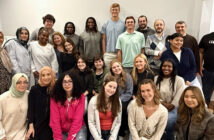Lehigh professor John Paul Balmonte’s research has brought him around the globe to exhibitions in Denmark, Sweden, and even the North Pole, for his involvement with the Multidisciplinary Drifting Observatory for the Study of Arctic Climate Expedition.
In the North Pole, Balmonte was captured in the PBS documentary, “Arctic Drift.” He took part in “MOSAiC,” the largest polar expedition in history, to gather data about arctic ice formations by riding a natural current called the Transpolar Drift.
“We went on the ship in two-month shifts to collect data, then we exchanged personnel,” Balmonte said. “It’s the largest Arctic expedition that we’ve ever carried out in the world, and now we have a wealth of continuous data over one year.”
Balmonte is a first-year assistant professor in Lehigh’s Earth & Environmental Sciences (EES) department. He is now the second oceanography-focused professor within Lehigh.
Before he arrived at Lehigh, Balmonte earned a master of science and doctorate in Marine Sciences from UNC Chapel Hill. There, he studied, and now continues to study, how microbes impact the carbon cycle and aquatic systems.
“The kind of research that I do is actually microbial and biogeochemistry, which sounds like it’s made up, but it actually is a discipline,” Balmonte said. “As you can imagine, it’s a combination of biology, geology and chemistry, it’s understanding how biology moves elements.”
Balmonte currently teaches a class called “Global Changes, Microbial Forces.”
A microbe, or microorganism, is a single-celled organism.
“They’re a huge source of carbon dioxide, but that’s just how they exist, the same way humans produce carbon dioxide when they breathe,” Balmonte said. “They’re also among the first responders to environmental change.”
Balmonte explained that microbes are quick to respond to environmental change, producing high amounts of carbon dioxide as temperatures rise.
“When we think about our climate feedback, I think we neglect a lot of the contributions and responses of the living organisms,” Balmonte said. “Ultimately, microbes run the world.”
Emma Andersen, ‘26, is enrolled in Balmonte’s course. She said she’s interested in the relationship between microbes and their impacts on different populations, especially given issues and differences in socioeconomic status.
Over the course’s semester-long project, each student must schedule a meeting with Balmonte to check on their progress, Andersen said.
“We walked into his office, and I saw this coffee pot, crackers and an assortment of food,” Andersen said. “I told him, ‘That’s an interesting lunch, JP,’ and he said, ‘Oh, it’s for you guys.’ To me, it kind of just demonstrated his personality and how he really cares about his students and wants them to be immersed while also being welcoming.”
Balmonte said he was attracted to Lehigh for its size, community and blend of teaching and research. He also said by joining the faculty as an oceanographer, Lehigh can provide more opportunities for students interested in oceanographic research and studies.
Joan Ramage Macdonald, a professor in the Earth and Environmental Sciences department and chair of the Hiring Search Committee, said when the department is looking to hire a new faculty member, they run a broad search to hear from the largest possible pool of applicants, which can range from tens to hundreds.
Macdonald said what made Balmonte an exceptional applicant was his passion for his work and his ability to demonstrate it to the search committee.
“People who are successful in this process both have excellent written applications explaining their strengths and our existing strengths working together, what attracts them to our department and how they would fit in, in addition to synergies with faculty who are already here,” Macdonald said. “It makes for a really nice environment. And then we also look for interesting, relevant and outstanding research, a commitment to excellent and inclusive teaching.”






Comment policy
Comments posted to The Brown and White website are reviewed by a moderator before being approved. Incendiary speech or harassing language, including comments targeted at individuals, may be deemed unacceptable and not published. Spam and other soliciting will also be declined.
The Brown and White also reserves the right to not publish entirely anonymous comments.